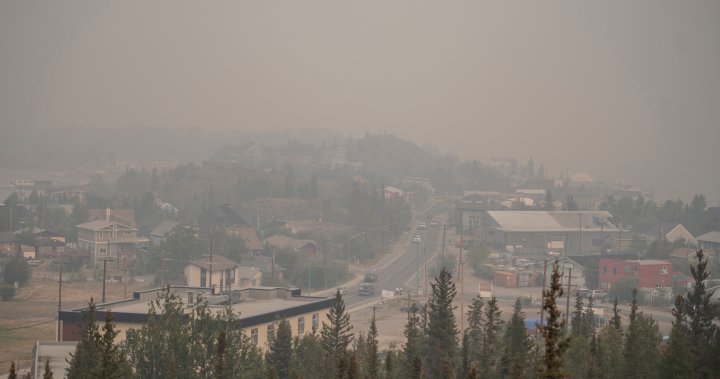By noon Friday, all Yellowknife residents should have fled the city to seek shelter away from the encroaching fires.
The evacuation order recommended people drive, but not everyone can.
The Stanton Territorial Hospital, the largest in the territory and centre of the acute care system, is in Yellowknife. It has 75 beds for services including surgery and cardiac care.
The city also has several long-term care facilities.
As of 6 p.m. Eastern time Friday, an Alberta Health Services spokesperson said they’ve placed 48 N.W.T. residents in spaces throughout the province and are preparing to support 150 to 200 more.
They also said staff are preparing for 33 obstetrical and 19 dialysis patients.

Evacuating a hospital or medical centre to keep patients safe from wildfires is a complex and potentially risky procedure, according to two people involved in past closures.
They said it involves planning, practice and adaptability.
Last May, approaching wildfires forced the Nova Scotia Health Authority to evacuate the Roseway Hospital in Shelburne, in the south of the province.
Tanya Nixon, the health authority’s vice-president for operations in the western zone, said staff moved patients with complex needs before the others.
“We ensured that their care plans were kept as up to date as possible and any type of special equipment or care needs that they may have were at the forefront in the event that we did have to evacuate,” she said in a telephone interview.
“Folks that could go home with support and were ready to go home,” she added, “were supported to go home.”
Nixon said most patients from the 22 acute medicine beds and emergency department were transported to Fisherman’s Memorial Hospital, about an hour away in Lunenberg, N.S.
Those who could sit for short distances were taken in buses, she said, while others who required stretchers were transported via ambulance.
“We took single rooms and turned them into double rooms and moved patients into rooms that were vacant so they could be settled,” Nixon said.
She said staff drew on plans and had practiced the evacuation many times before the fire forced them to leave.
“While (evacuations) are high pressure situations, we have checklists and processes that are well-established that we have practiced.”

In the lead up, staff had meetings once a day and then twice or more as the flames approached.
They also already had personnel in Fishermen’s Memorial Hospital who helped ensure the right number of beds, mattresses and any specialized equipment was there or could be transported.
They also carried paper copies of patients’ medical records, in case new staff had any difficulty accessing the files digitally.

Dr. Louis Fransecutti, who cared for patients taken from Fort McMurray’s hospital during the 2016 wildfires, said it is vitally important that healthcare administrators sort out the logistics before an evacuation.
“Any upcoming surgeries that are urgent, that need to be done, have to be passed on to the receiving facility, as well,” he said.
He also said its important all residents, not just those needing immediate care, take responsibility for themselves and stock up on gas, batteries and cash.
“Ensure that you’re able to take care of yourself for at least the first 48 hours. Don’t rely on others.”

“It’s not as if 20,000 people are going to show up needing healthcare the moment they arrive,” he said, referencing the population of Yellowknife.
“But they have to be prepared. So they should have enough of their medication so that… they’re not going to run out of their heart meds or their birth control pills or their asthma puffers.”
Speaking from Edmonton, he also recommended people have a written list of their medical conditions that they can give to healthcare workers if needed.
Everyone needs to be able to adapt very quickly to changing conditions, he stressed.

Fransecutti also said healthcare workers in the process of evacuation need to be able to take care of themselves and each other, and not just patients.
Nixon admitted that is something they didn’t anticipate.
“The area that the hospital was in was in a evacuation zone,” she said.
“And we didn’t consider how staff and physicians would get their vehicles off the property afterwards.”
She said the health authority now has plans in place.




